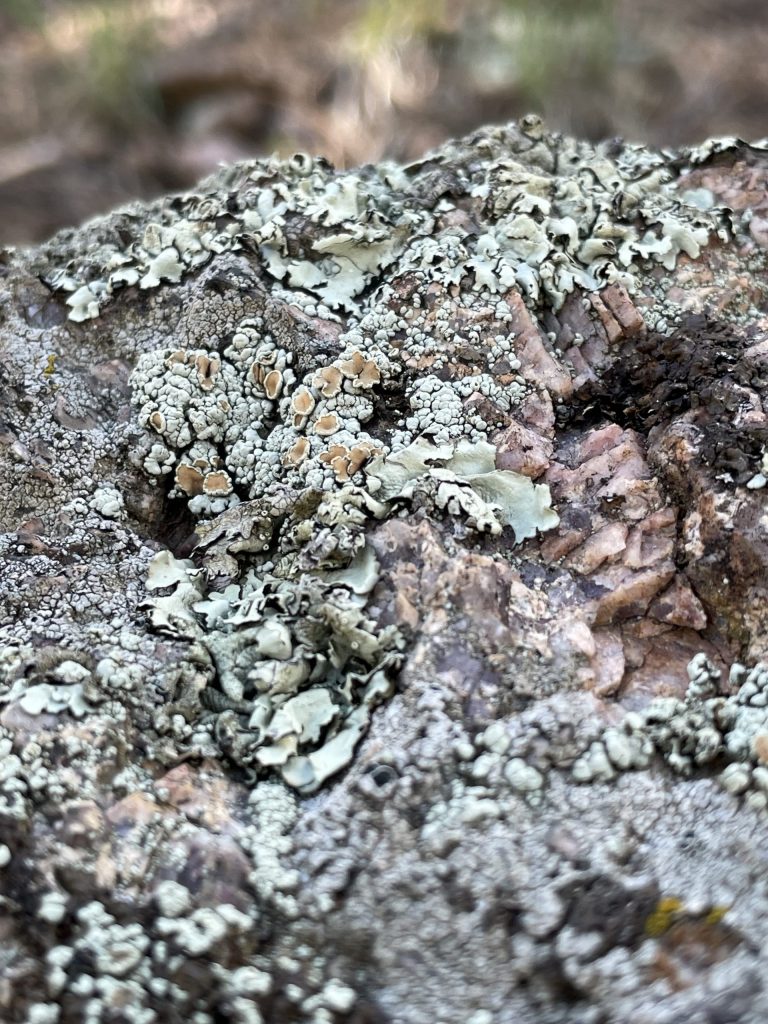I recently finished watching National Geographic’s latest exploration of the natural world—a rather close examination of its insects, aptly titled A Real Bug’s Life, in a playful nod to Disney’s animated 1998 feature film A Bug’s Life. Over the years, I’ve grown to appreciate this type of nature documentary more and more—other favorites include Apple’s Tiny World (2020–21) and Netflix’s Tiny Creatures (2020)—where the micro becomes the macro in a dazzling, otherworldly fashion. These documentaries push viewers to appreciate what largely goes unnoticed in everyday life, and this is often accomplished through stunning close-up cinematography.
Macro nature photography can tap into the same sensibilities as those probing docuseries, and the results can be similarly spectacular and illuminative. It can also facilitate micro-level contemplation in a different sort of macro sense, helping us perceive the world differently through the extolment of the ordinary as extraordinary—dissolving the line between the marvelous and the mundane. The practical, medicinal, and delicious qualities of what often get disparaged as weeds can indeed be part of this contemplation, as can the allure and mystery of the evanescent mushroom. But when our awareness is fundamentally altered, their myriad colors and levels of interconnected complexity, which are as striking as they are beautiful, also become more pronounced by paying closer attention.
Lately, my attention has narrowed even further. Noticing the greenery pushing its way up through cracks in the sidewalk, or berried branches inching their way out of a hedge, is perhaps a stepping stone to homing in on the bright orange specks seemingly splattered against the side of a tree or the dark gray scales cascading over the recesses of a slaty stone. Lichens are some of the tiniest organisms one is likely to encounter on an afternoon walk—anywhere, because they can be found almost everywhere.
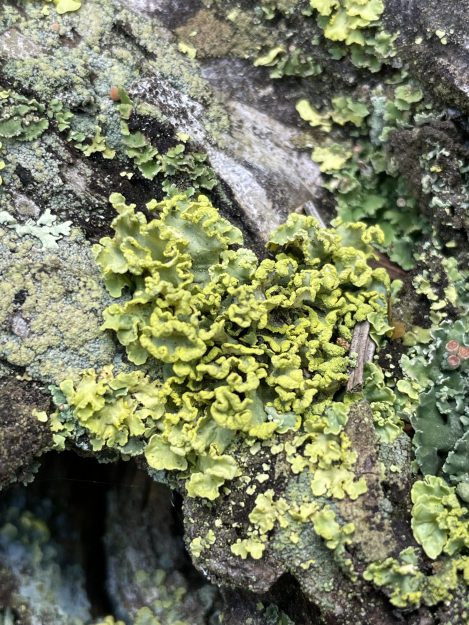
Vulpicida pinastri. Foliose. On a downed tree near Emerald Lake in Rocky Mountain National Park, Colorado. Photo by Seth M. Walker.
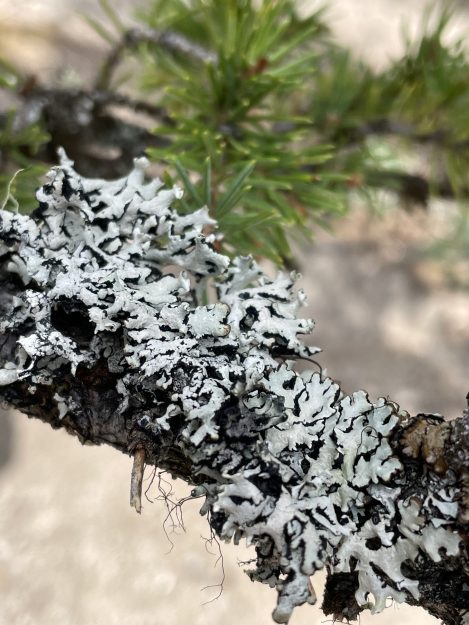
Hypogymnia physodes. Foliose. Growing across a branch along the shore of Moraine Lake in Banff National Park, Alberta. Photo by Seth M. Walker.
Lichens have been around for an incredibly long time and are able to survive and thrive in the harshest of environments and conditions. But you can’t just plant a lichen in your favorite garden nook as you would cucumbers or tomatoes; there’s hardly a possibility it would recover from the move. Lichens maintain an extreme causal connection to place and are thus valued through discovery rather than cultivation. This makes locating any of the roughly 20,000 identified species particularly special and unique, since the impressive slowness of their annual growth (often measured in millimeters) also signals their connection to the impermanence of place and their conditioned adaptability. When you see surfaces covered with expansive lichen growth, there’s a good chance that particular specimen is tens, if not hundreds—or thousands—of years old (scientists even use lichen growth rates for dating exposed rock surfaces because of this—a method known as lichenometry).
But discussing lichens as singular entities is a sort of shorthand categorization similar to talk of a “self” in Buddhist philosophy. Categories are useful for their analytic value, of course, and practical ways to discuss visually distinct bodies also help make life a lot easier to navigate, structure, and examine. Nevertheless, as Buddhist teachings pertaining to anatta (nonself) and the khandhas (the five aggregates of clinging) emphasize, there is nothing singular, static, or separate about “you” and “I”: we are interconnected, interrelational, and interdependent with everything surrounding us.
In her work The Lichen Museum (2023), artist-activist A. Laurie Palmer refers to them as the “poster child for symbiosis.” The book project is concerned with how lichens can inform our understanding of what it means to be human, particularly in terms of our connection to others and place. Given their ubiquity, the title alludes to Palmer’s framing of the world as one gigantic lichen art display, inviting readers to stop, look, appreciate, and learn from these beings. These symbiotes are composed mainly of a fungus (the mycobiont) and either an alga or a cyanobacterium (the photobiont). The mycobiont provides its photosynthesizing partner with mineral nutrients and structural support, while the latter supplies the fungal component with energy via the fixation of carbon or nitrogen. But within this predominant partnership, there might also exist countless other bacteria and fungi, all sustaining one another as an aggregate entity, interconnected, in complete reliance upon its constituents.
Even more than their composite nature, the seductive diversity of lichens is what has me staring at the ground, alongside rock walls, and up the trunks of downed trees through a magnifying lens.
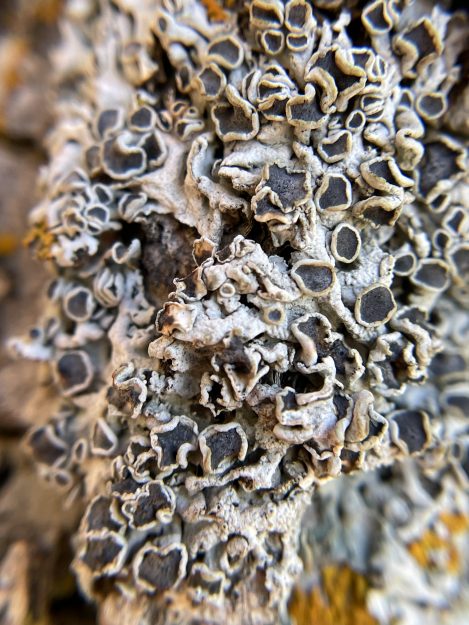
Physcia biziana. Foliose. Growing along tree bark in Mesa Verde National Park, Colorado. Photo by Seth M. Walker.
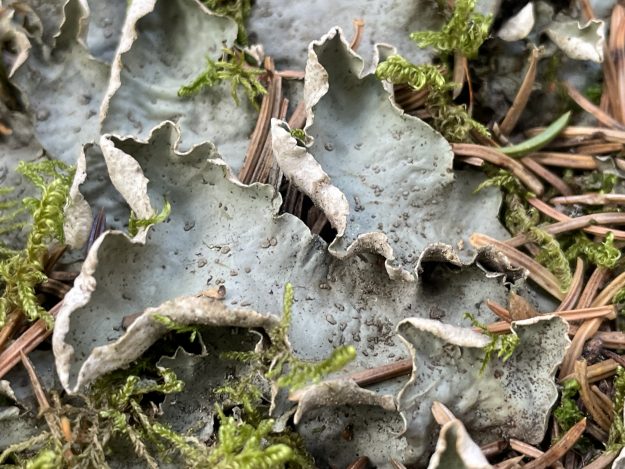
Peltigera aphthosa. Foliose. Poking through ground moss along the shore of Moraine Lake in Banff National Park, Alberta. Photo by Seth M. Walker.
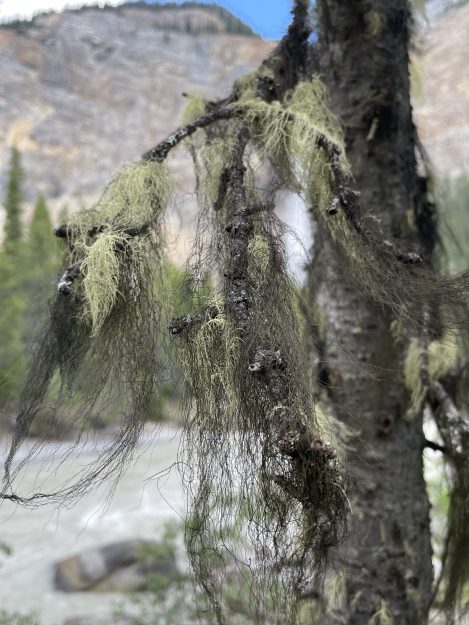
Bryoria fuscescens and Usnea hirta. Fruticose (branched). Hanging from a tree near Takakkaw Falls in Yoho National Park, British Columbia. Photo by Seth M. Walker.
Miksang (“good eye”) is a contemplative photographic tradition developed out of the teachings of the Shambhala community of Tibetan Buddhism. This tradition emphasizes a photography practice that aims to view things simply as they are, placing a strong emphasis on remaining inquisitive throughout our lives, being aware of not just what we see but also how we see it—and, most importantly, being aware of how our perception of things affects our minds. “The power of Miksang experience,” Michael Wood states in his book Opening the Good Eye (2016), “lies in the singularity and simplicity of each moment…If we can begin by seeing just one thing clearly, understanding it perfectly, and expressing it genuinely, then our vision can open up into the bigger world with the same discipline and confidence.” Miksang practice is concerned with liberating our typical experience of the world through direct and clear perceptions of the ordinary and the conventional, and bringing that heightened awareness into our everyday lives.
When we stop and focus our gaze on an unassuming splotch of color—when we perceive it directly—we allow ourselves to see that splotch of complex life and how it intermingles with its surroundings. And this is the vision characterizing Miksang. “Being engaged in our ordinary world is at the absolute core of this practice,” Wood notes. “Our process is to open ourselves to our everyday experience, see it precisely, understand it thoroughly, and express it accurately with gentleness and elegance. . . . When we bring our gaze to the intimate, close world around us, then we are able to see the world changing and manifesting in front of us.” This is one of the main reasons Palmer invites readers to the so-called Lichen Museum: to experience that intimacy up close and contemplate what lichens can teach us as they display such expressive principles of causality and idappaccayata (this/that conditionality) in a tantalizing spectrum of colors and exciting features. And given their size, most of them require the magnification of a lens in order to be fully regarded and contemplated.
In many ways, contemplation is photography: we capture moments and images throughout our lives and selectively shuffle through those archived memories upon reflection and deeper consideration. A magnified picture of an organism that subverts typical classificatory paradigms can more easily focus our attention on the basic facts surrounding its existence and help us bring that understanding—of interconnection, interrelatedness, and interdependence—to the way we view ourselves and others, and to our perception of the world outside that captured moment.
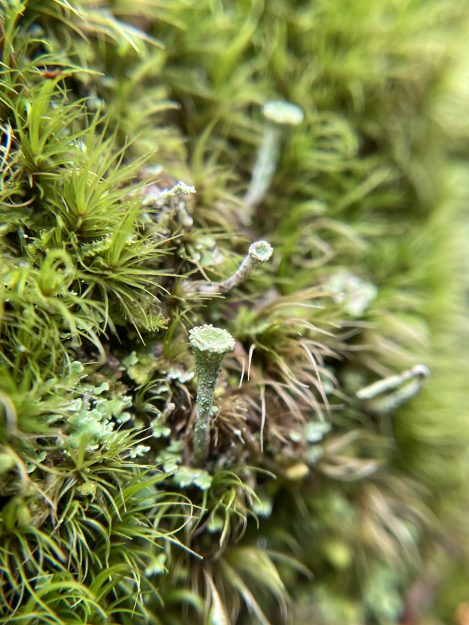
Cladonia fimbriata. Squamulose (scalelike) with podetia (stalks). Nestled in a downed, moss-covered cedar near Avalanche Lake in Glacier National Park, Montana. Photo by Seth M. Walker.
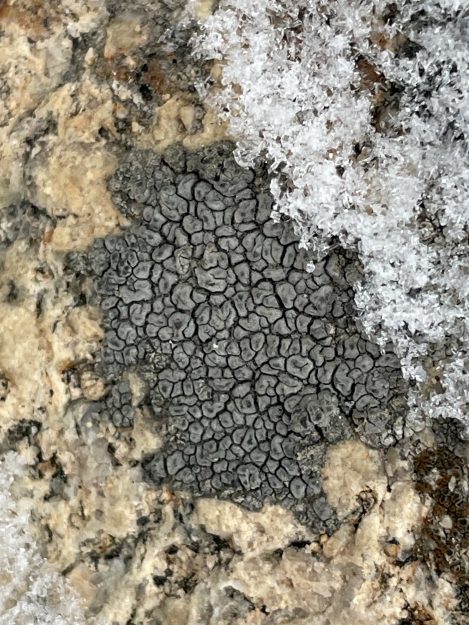
Aspicilia cinerea. Crustose (flattened). Partially covered in snow on a boulder in Dillon, Colorado. Photo by Seth M. Walker.
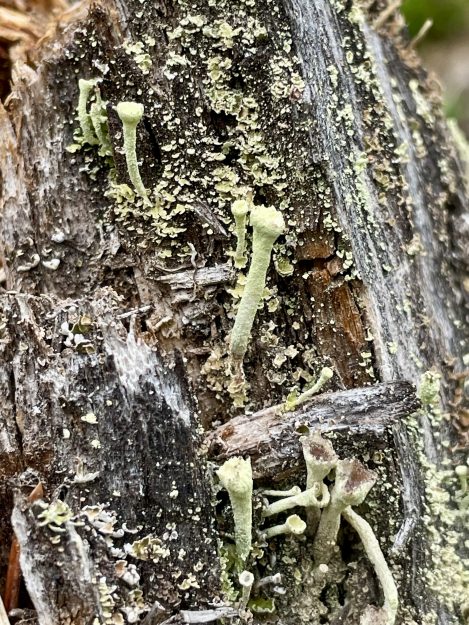
Cladonia fimbriata. Squamulose with podetia. Protruding from a decaying stump near Takakkaw Falls in Yoho National Park, British Columbia. Photo by Seth M. Walker.
Being attentive to lichens, Palmer indicates, is tantamount to being attentive to our relationships and “qualities of connection”—about valuing those “forms of life and being that are generally ignored if not literally stepped on, and learning from those beings how we might practice living differently.” This becomes part appreciation and part reorientation—a similar sort of symbiotic partnership—when the nuances of lichen identity are made clear upon inspection and are further contemplated. “Given their collective constitution,” Palmer states, “(a) lichen(s) is/are neither singular nor plural—becoming their multiple selves through entangled relationships. . . . If you pursue the implications of both this adaptive, relational ‘identity’ and the magnificent morphological creativity resulting from it, you find reasons to question, counter, and try to unravel mistaken and consequential assumptions about what constitutes an individual organism, as well as about what being in relation might mean.”
Palmer might as well be paraphrasing the Anatta-lakkhana Sutta’s teachings (SN 22:59) on not-self: “Every form is to be seen with right discernment as it has come to be: ‘This is not mine. This is not my self. This is not what I am.’ ” The move from an independent to an interdependent perspective can be just as troubling today as it was when the Buddha gave that second major sermon, but an existential shift like this is exactly what Miksang practice is meant to help facilitate—as long as we’re open to it and willing to let go of any preconceived notions and attachments to reality as it appears. Our everyday perceptions take place as if on the other side of a window, Wood explains. And without a clean window, we’ll never really see what’s right in front of us.
The transcendentalist writer Henry David Thoreau often wrote of “lichen days” in his many detailed journals: days that were characterized by mist, fog, clouds, and rain—days that could have just as easily been framed as gloomy, dismal, or grim. But for him, they were filled with just as much awe and beauty as the sunniest days of a New England forest—if not more, given their comparative rarity. Writing of a low mist in the woods, on December 31, 1851, he states how the hazy ambience simply “compels your attention to near objects, and the white background reveals the disks of the lichens distinctly. They appear more loose, flowing, expanded, flattened out, the colors brighter for the damp…This is their solstice, and your eyes run swiftly through the mist to these things only.”
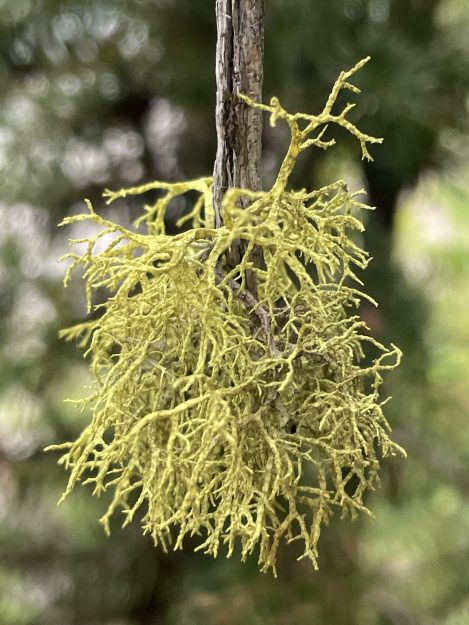
Letharia vulpina. Fruticose. Hanging from a branch along the shore of Moraine Lake in Banff National Park, Alberta. Photo by Seth M. Walker.
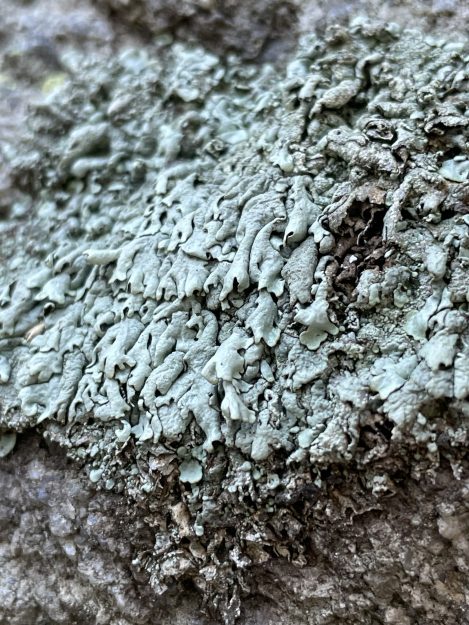
Physcia caesia. Foliose. Covering stones along the trail to Lake Haiyaha in Rocky Mountain National Park, Colorado. Photo by Seth M. Walker.
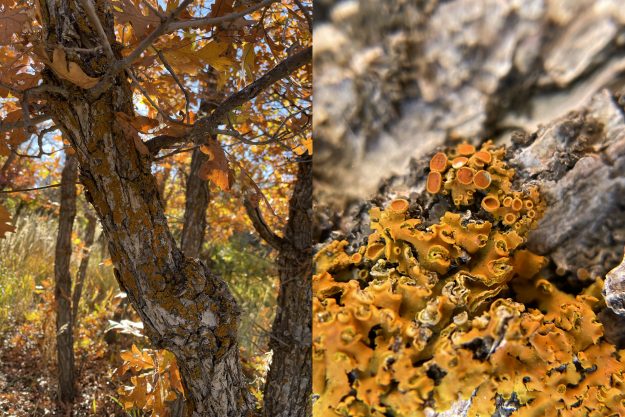
Xanthoria fallax. Foliose. Blending in with fall foliage in Mesa Verde National Park, Colorado. Photo by Seth M. Walker.
This is the type of focus Miksang practice encourages. Whether it’s through the metaphorical polished glass window no longer obscuring our view, or in a thick forest mist that highlights what might otherwise be passed over in our gaze, Miksang is concerned with an open and pointed orientation toward our spectacular world. And when some of the most illuminating and revealing features of that world present themselves at such a tiny level, a magnifying lens and viewfinder hold the power to further engage with the ramifications of these blurred boundaries—between subject, observer, and place.
To truly observe lichens is to contemplate the multiplicity of self and the ostensible nature of individuality and interaction. It challenges us to recognize that it is not our apparent separateness or presumed essential natures that make living worthwhile, but the collective interdependencies that link us and everything around us together in a perfect and impermanent state of interrelational existence.
Thank you for subscribing to Tricycle! As a nonprofit, we depend on readers like you to keep Buddhist teachings and practices widely available.
